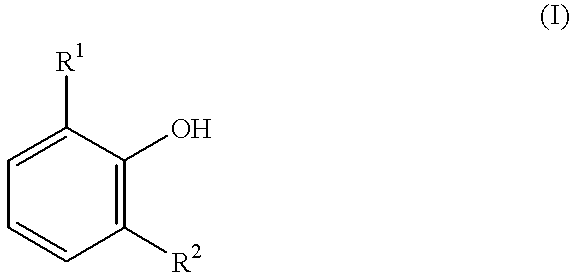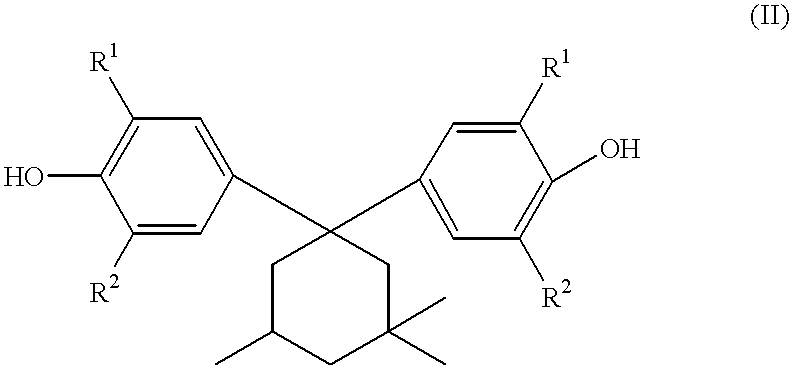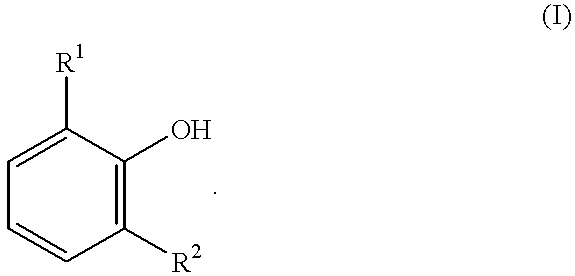Process for producing 3, 3, 5-trimethylcyclohexylidenebisphenol
a technology of trimethylcyclohexylidene and trimethylcyclohexylidene, which is applied in the direction of physical/chemical process catalysts, organic chemistry, chemistry apparatus and processes, etc., can solve the problems of abnormally high extremely low reaction rate, and extremely slow reaction speed, so as to suppress the rise of the viscosity of reaction mixture and high yield
- Summary
- Abstract
- Description
- Claims
- Application Information
AI Technical Summary
Benefits of technology
Problems solved by technology
Method used
Image
Examples
example 1
62.5 g (0.665 mol) of phenol, 7.6 g of water and 4.2 g of octylmercaptan were charged into a 1000 ml four-necked flask equipped with an agitator, a torque meter, a thermometer, a dropping funnel and a reflux condenser. While maintaining the internal temperature at 20 to 30.degree. C., the interior of reaction system was purged with nitrogen gas and hydrogen chloride gas was blown thereinto until the system interior was saturated with hydrogen chloride gas.
While maintaining the internal temperature at 25 to 30.degree. C., a liquid mixture of 78.5 g (0.835 mol) of phenol and 42.0 g (0.300 mol) of 3,3,5-trimethylcyclohexanone was dropped into the flask contents over a period of 3 hr to carry out a reaction. Before the dropping reaction, the flask contents were in the form of a solution and the agitator torque was 1.2 kg / cm. However, at the completion of the dropping reaction, the flask contents were in the form of a slurry and the agitator torque was 2.5 kg / cm. Further, at the completi...
example 2
62.5 g (0.665 mol) of phenol, 7.7 g of water and 5.8 g of dodecylmercaptan were charged into a 1000 ml four-necked flask having the same equipment as in Example 1. While maintaining the internal temperature at 20 to 30.degree. C., the interior of reaction system was purged with nitrogen gas and hydrogen chloride gas was blown thereinto until the system interior was saturated with hydrogen chloride gas.
While maintaining the internal temperature at 25 to 30.degree. C., a liquid mixture of 78.5 g (0.835 mol) of phenol and 42.0 g (0.300 mol) of 3,3,5-trimethylcyclohexanone was dropped into the flask contents over a period of 3 hr to carry out a reaction.
Before the dropping reaction, the flask contents were in the form of a solution and the agitator torque was 1.7 kg / cm. However, at the completion of the dropping reaction, the flask contents were in the form of a slurry and the agitator torque was 4.3 kg / cm. Further, at the completion of the dropping reaction, the conversion of 3,3,5-tri...
example 3
37.2 g (0.396 mol) of phenol and 9.0 g of water were charged into a 1000 ml four-necked flask having the same equipment as in Example 1. While maintaining the internal temperature at 20 to 30.degree. C., the interior of reaction system was purged with nitrogen gas and hydrogen chloride gas was blown thereinto until the system interior was saturated with hydrogen chloride gas. Thereafter, 3.8 g of a 10% aqueous methylmercaptan sodium hydroxide solution was charged into the reaction system.
While maintaining the internal temperature at 25 to 30.degree. C., a liquid mixture of 110.4 g (1.174 mol) of phenol and 42.2 g (0.301 mol) of 3,3,5-trimethylcyclohexanone was dropped into the flask contents over a period of 3 hr to carry out a reaction.
Before the dropping reaction, the flask contents were in the form of a solution and the agitator torque was 1.1 kg / cm. However, at the completion of the dropping reaction, the flask contents were in the form of a slurry and the agitator torque was 1....
PUM
| Property | Measurement | Unit |
|---|---|---|
| Percent by mass | aaaaa | aaaaa |
| Percent by mass | aaaaa | aaaaa |
| Angle | aaaaa | aaaaa |
Abstract
Description
Claims
Application Information
 Login to View More
Login to View More - R&D
- Intellectual Property
- Life Sciences
- Materials
- Tech Scout
- Unparalleled Data Quality
- Higher Quality Content
- 60% Fewer Hallucinations
Browse by: Latest US Patents, China's latest patents, Technical Efficacy Thesaurus, Application Domain, Technology Topic, Popular Technical Reports.
© 2025 PatSnap. All rights reserved.Legal|Privacy policy|Modern Slavery Act Transparency Statement|Sitemap|About US| Contact US: help@patsnap.com



